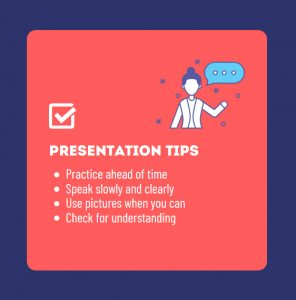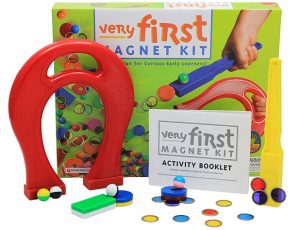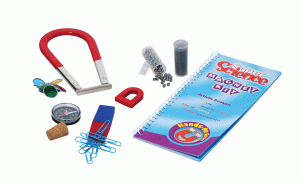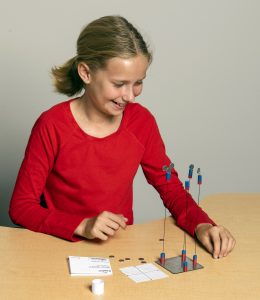Going Virtual—Experiments & Tips for Virtual Science Fairs!
Whether you’re looking for science experiments to keep your kiddos busy or need a science fair project to present virtually, we’re sharing a few of our favorite, magnetism experiments below. And keep on reading for tips on presenting a science fair project virtually!
Science Project Experiment (ages 4–7)
Magnetic Properties: explore the concept of magnetism and understand which objects are magnetic, and which are not. (Experiment is from the booklet in the Very First Magnet Kit.)
- Start by collecting a range of objects around the house, including corks, coins, buttons, screws, nuts, bolts, washers, paper clips, dried beans, and more.
- Next, use a variety of magnet types, like the magnet wand or horseshoe magnet found in the Very First Magnet Kit, to attempt to pick up each object.
- On a sheet of paper, record which items were attracted to which type of magnet and which type were not attracted to any of your magnets. What do the magnetic objects have in common?
Very First Magnet Kit is designed for grades PreK+
Science Project Experiment (ages 8–10)
Magnets in Motion (in water!): make your own compass using a bar magnet and a bowl of water! (Experiment is taken from the Super Science Magnet Kit booklet.)
- Place a red/blue bar magnet, like the one found in the Super Science Magnet Kit, in a small (empty) plastic bowl.
- Fill a larger plastic bowl with water. Carefully float the smaller bowl inside.
- Let the water settle. Check the direction of the bar magnet.
- Hold a compass in your hand. Determine which direction is north, and then compare it to the direction shown on your bar magnet.
- Spin the bowl and check the direction again. What do you notice?
Super Science Magnet Kit is designed for grades 3+.
Science Project Experiment (ages 10–14)
Earthquake Engineering: explore kinetic energy and experiment with various shock absorbing materials to simulate the design of an earthquake-resistant building foundation! (Experiment is from the Wave Wires® Magnet Set booklet.)
- Using magnets mounted on the ends of sturdy wires and a steel base plate, like those found in the Kinetic Magnetics® Wave Wires® Magnet Set, place two 6mm magnet wires, with the same poles down, about 1” apart on the center of the base.
- Use a plastic ring to activate the wires and use a stopwatch or your smart phone to record the time it takes for them to stop moving.
- Place a layer of packing foam, bubble wrap, or tissue paper under the base and repeat steps 1 and 2.
- What is causing the difference? (Hint: the materials beneath the base act as shock absorbers, reducing the magnets’ movement, much like base isolators do in the construction of buildings.)
Kinetic Magnetics® Wave Wires® Magnet Set is designed for kids in grades 3+.
Science Project Extension Resources
Keep the fun (and the learning!) going by extending the projects further! Use our free downloadable magnet mini book, magnet shapes journal, and magnetism crossword puzzle. If your kids get stuck, they can get help from our magnet Q&A or from our giant online magnetism glossary – the largest magnetism glossary around! For even more ideas and projects, visit our idea center!
Virtual Science Fair Tips
 If your science fair has suddenly gone virtual, don’t worry! Try these simple tips for a stress-free presentation:
If your science fair has suddenly gone virtual, don’t worry! Try these simple tips for a stress-free presentation:
- If you will be presenting via an online conferencing tool/app, be sure to download it well in advance. If possible, use that exact tool/app to do a trial run of your presentation online (to try to prevent last-minute technology glitches).
- Speak slowly, clearly, and loud enough for your interactive audience to hear you. Your volume will vary based on the technology tools used by both you and those watching/listening to you, but you can practice your pace and clarity ahead of time with family members at home.
- Sharing visuals as you speak breaks up your presentation, which is more interesting to viewers than you talking straight into the camera the whole time.
- Don’t worry if you don’t have a big, tri-fold board at home. Instead, scan or take photos of your experiment steps in action, materials list, data sheets, charts, graphs, and other images. Then, either hold up these visuals (ideal for younger children), or more advanced children can turn them into a slideshow ahead of time (that can be shown by sharing your screen with your audience).
- Make sure you meet all the specific requirements—that your teacher/school provided to you ahead of time—for your science fair project. Remember to either EXPLAIN ALOUD or SHOW each requirement/step, and if needed, repeat the most important ones. (When your audience—and JUDGES—hear or see the requirements/steps, they’ll know for sure that you completed each one!)
Tags: at home science , Science Fair Projects , virtual science fair
Share This:



